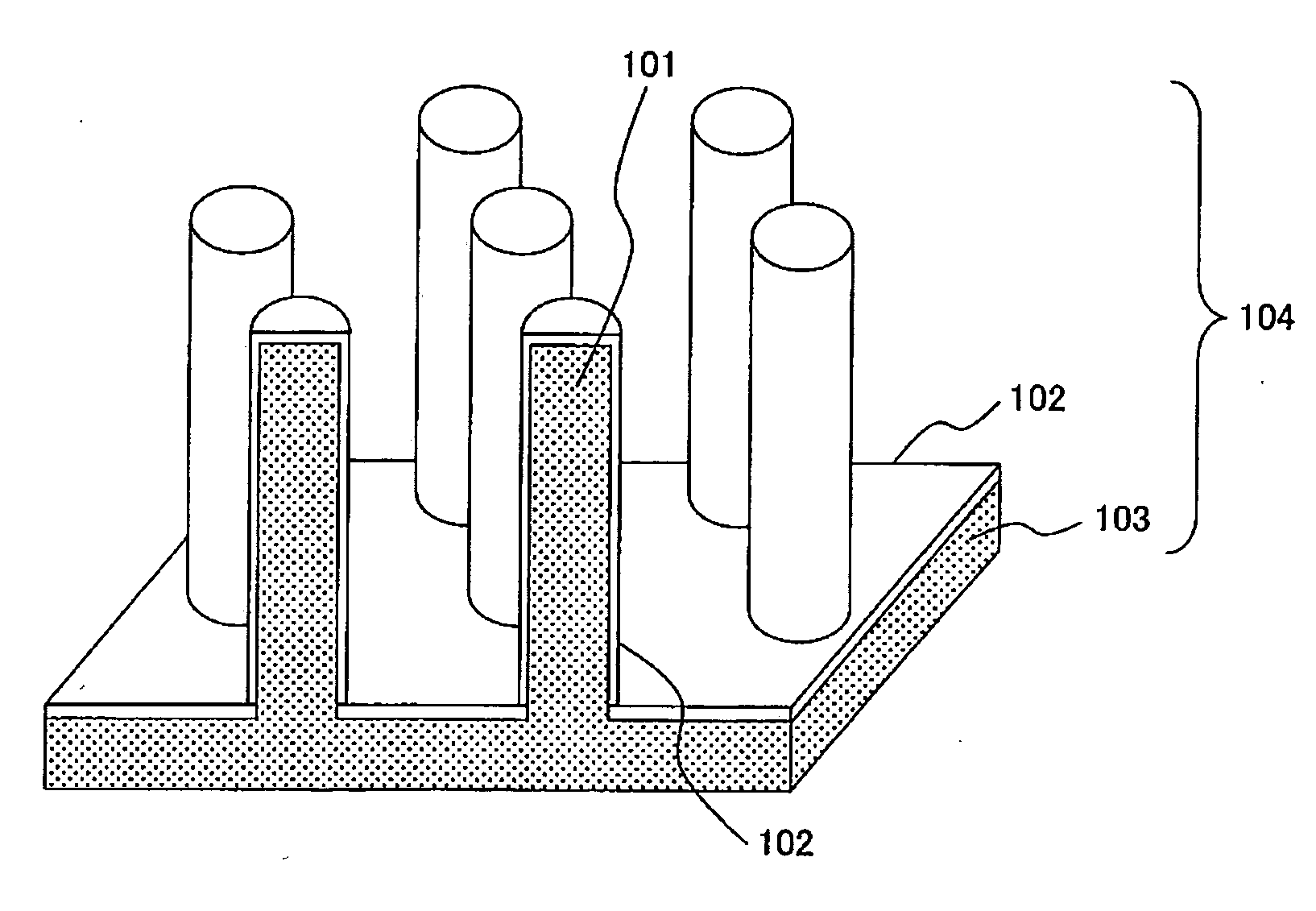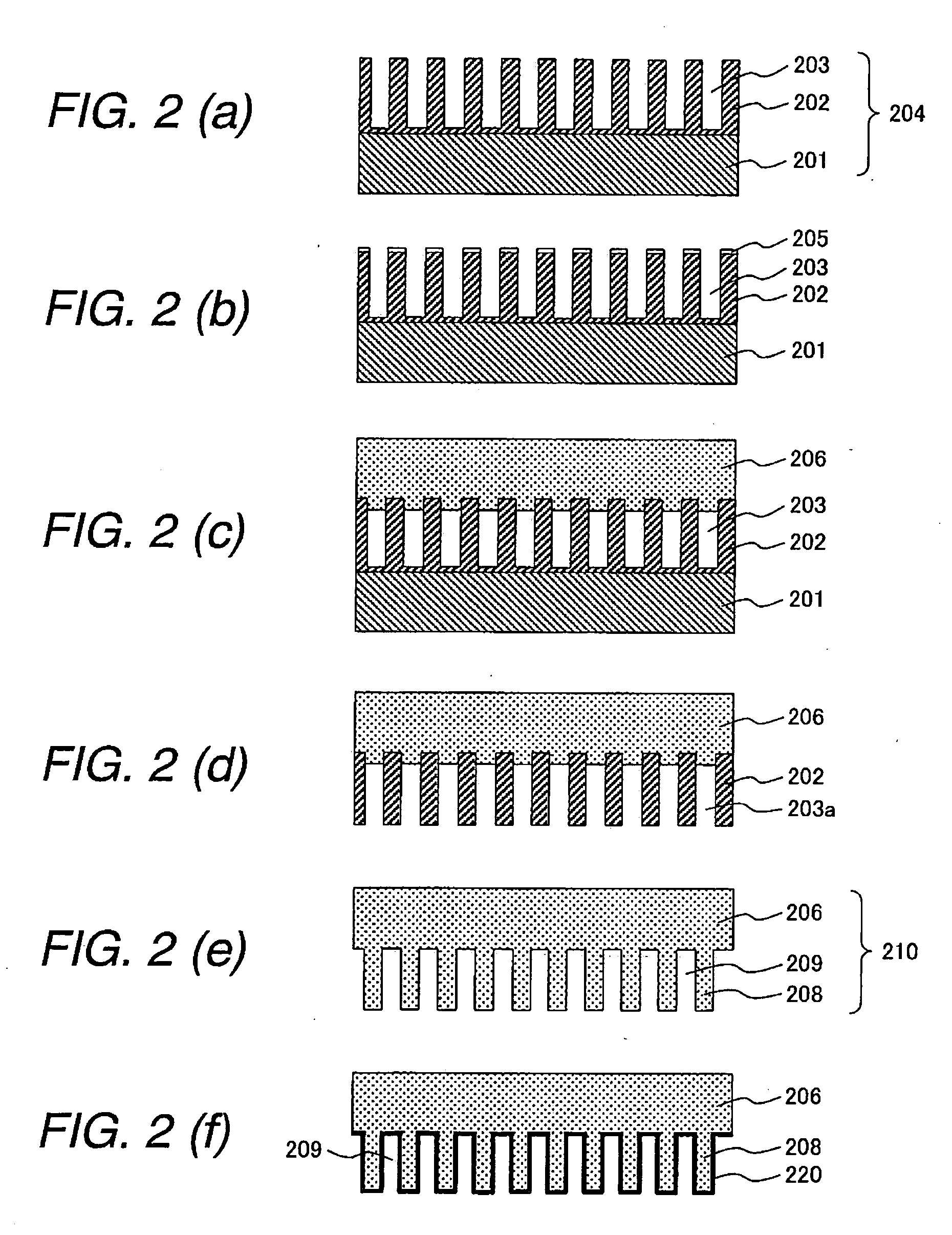Electrode for use in electrochemical device, solid electrolyte/electrode assembly, and production method thereof
- Summary
- Abstract
- Description
- Claims
- Application Information
AI Technical Summary
Benefits of technology
Problems solved by technology
Method used
Image
Examples
example 1
[0059]FIG. 1 is a perspective view showing an example of an electrode for use in electrochemical device according to the invention. An electrode 104 comprises a metal structure 103 having a group of micro-pillars 101 formed on the surface thereon, and an electrode active material 102. While the shape of the micro-pillar is a cylindrical columnar in FIG. 1, it may be a square cylindrical columnar (pillar) 302, and cylindrical columnar pillars and square cylindrical columnar pillars may also be present together. There is no particular restriction for the micro-pillars.
[0060] The electrode for use in electrochemical device of the shape shown in FIG. 1 was produced by production steps shown in FIGS. 2A to 2F.
[0061]FIG. 2A shows a substrate having pores. The substrate can be formed by anodic oxidation of an aluminum plate 201 in an acidic solution, for example, a solution of oxalic acid, chromic acid, or sulfonic acid. Anodized alumina 202 is formed on the surface of the aluminum plate...
example 2
[0068] In this example, a metal structure comprising nickel was produced by the same method as in Example 1, and ruthenium and platinum were formed as an active material onto the surface of micro-pillars comprising nickel. Specifically, by electrodepositing a metal structure in an aqueous alkali solution containing 0.05 mol / dm3 of ruthenium chloride, a ruthenium metal film was formed on the surface of the micro-pillar. Ruthenium was electrodeposited potentiostatically while measuring a current such that the surface thickness of nickel was about 5 nm.
[0069] Successively, platinum was deposited on the surface of the ruthenium metal film by electrodeposition using a pulse current in an aqueous solution containing 0.03 mol / dm3 of chloroplatinate. Granular platinum could be formed on the surface of the ruthenium metal film.
[0070]FIG. 5 shows a perspective view of an obtained electrode. A ruthenium metal film 502 was formed directly on the surface of each micro-pillar 208 of the metal s...
example 3
[0072] In this example, a metal structure having micro-pillars was produced by the same method as in Example 1, and a multilayered layer comprising a ruthenium metal film and a ruthenium oxide film was formed on the surface of micro-pillars comprising nickel.
[0073] Specifically, by electrodepositing the metal structure in an aqueous alkali solution containing 0.05 mol / dm3 of ruthenium chloride, a ruthenium metal film was formed on the surface. Successively, by electrochemical oxidation in a solution of sodium hydroxide, the surface portion of the ruthenium metal film was oxidized to form a ruthenium oxide film. The solution is not restricted to that of sodium hydroxide so long as it is an aqueous alkali solution.
[0074] Also in this example, since the active material can be formed directly to the conductive skeleton, a conducting aid for connecting the active materials to each other may not be added at all. The electrode of this example can be provided as a high performance capacit...
PUM
| Property | Measurement | Unit |
|---|---|---|
| Structure | aaaaa | aaaaa |
Abstract
Description
Claims
Application Information
 Login to View More
Login to View More - R&D
- Intellectual Property
- Life Sciences
- Materials
- Tech Scout
- Unparalleled Data Quality
- Higher Quality Content
- 60% Fewer Hallucinations
Browse by: Latest US Patents, China's latest patents, Technical Efficacy Thesaurus, Application Domain, Technology Topic, Popular Technical Reports.
© 2025 PatSnap. All rights reserved.Legal|Privacy policy|Modern Slavery Act Transparency Statement|Sitemap|About US| Contact US: help@patsnap.com



